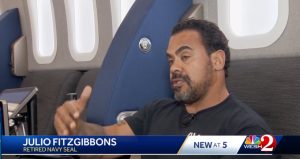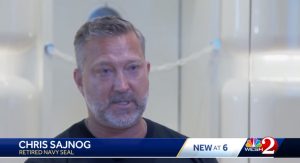There is compelling evidence to suggest that Hyperbaric Oxygen Therapy (HBOT) may significantly reduce the negative symptoms experienced by TBI patients and PTSD patients, even years after the incident. This therapy to help heal PTSD and TBI made news headlines on WESH2.
Learn more….
THE VILLAGES, Fla. —
Stepping into the Aviv Clinics in The Villages feels like walking into the future of medical care.
From the slick, minimalistic lobby that feels reminiscent of an upscale airline lounge to the client-experience concierge who greets people when they arrive, it is clear that the treatment facility is aiming for something different in the health care arena.
When you walk through the lobby doors and past the multiple exercise and physical therapy rooms lining the facility, you reach the centerpiece of Aviv Clinics: the hyperbaric oxygen chambers.Inside the four chambers looks like an airplane cabin. But the people who sit in the seats are not going for a flight, they are going for a ‘dive’ as doctors call it.
Four retired Navy SEALs who suffer from post-traumatic stress disorder and traumatic brain injuries sat in those seats. Doctors said the treatment they get inside the chamber will help them heal.
One of those veterans is Julio Fitzgibbons. Fitzgibbons traveled to Central Florida from Colorado. He served in the armed forces for over 30 years and was deployed to Iraq and Afghanistan.
“I got off my last deployment in 2020. And I was stuttering, having a lot of issues cognitively. I couldn’t remember short-term, long-term, from names to locations of where I’m going or who’s who. A lot of my SEAL friends told me, ‘hey, you need to go get help,’” Fitzgibbons said.
The 51-year-old said that was when he discovered he had a traumatic brain injury, or TBI.
“We’ve breached so many doors. We’ve blown up so many things that I could never pinpoint to one specific thing,” he said. “It’s just a multitude of years of just training. Not just the wars, the training just to get to that, to go to war causes a lot of the issues to that they don’t look at.”
Fitzgibbons said his TBI and PTSD pushed him into a deep depression.
“I knew my life was great. I was happy as hell. But I was dying inside,” he said. “It was just a blackness in my soul that just made me so depressed and so sad that it drove me to the point where I put the gun in my mouth. Which was the hard part. And a friend of mine saved my life by calling me at the right time and got me treatment initially. And then they got me out here.”
Chris Sajnog, 52, came to Florida from California for treatment after discovering last year that he had a massive brain injury to 70% of his brain.
“The doctor said, ‘I don’t even know how you’re doing basic function,’” he said. “He compared my brain to a linebacker in the NFL.”
Sajnog served in the military for 20 years as a medic and lead sniper instructor. In fact, he put together the SEALs’ sniper manual.
“As a Navy SEAL, we’re around a lot of explosives. A lot of shooting big guns and jumping out of things and landing hard on things and one of the big things is shooting shoulder-fired weapons,” he said. “So every time you shoot that, it’s right next to your head and it’s a major concussive event that just keeps happening, for me, for 16 years.”
Sajnog said his TBI has taken a major toll on his work. After retiring from the Navy, he became a firearms instructor and wrote three best-selling books. He also has a YouTube channel that has garnered over 220,000 followers.
“I can’t do that anymore,” he said. “It’s just really hard for me to do. So it’d be nice to produce more content and teach more people. I really do love doing it.”
For both men, their TBI and PTSD were severely impacting their lives. They are able to get this help thanks to the military support group America’s Mighty Warriors and Aviv Clinics.
Debbie Lee, the founder of America’s Mighty Warriors, told WESH 2 that she started the organization for her son, Marc Lee. She said he was the first Navy SEAL killed in Iraq.
“Mark may be gone from this world, but he is still saving his teammates’ lives,” Lee said.
“I am so happy they selected me, truly, because this is a once-in-a-lifetime thing,” said Fitzgibbons.
Dr. Mohammed Elamir explained how the treatment works.
“They are sitting in here two hours a day, five days a week for up to 12 weeks,” he said. “We close the doors, build the pressure up and they start to breathe 100% oxygen for 20 minutes. While that’s happening, their oxygen level’s very high, and then they just take the mask off for five minutes. And they are doing this back and forth.”
Elamir said this process heals the brain. He explained that the pressure in the chamber is equivalent to diving 33 feet below sea level. He said breathing oxygen under that pressure increases the concentration of the oxygen 17 times and allows more of it to get to the cells that need it.
“So if I have an injured brain that has lack of blood flood, has damage, has decreased metabolism, I can put them through this treatment and build new blood vessels, build new cells, build new connections and help the function thereby addressing the cause of somebody’s symptoms,” Elamir said. “Their anxiety is less. Their depression is potentially no longer existent.”
The treatment continues outside of the chamber too. It is a holistic approach complete with a medical team, dietician, neuropsychologist, physical therapist and exercise physiologist.
Aviv Clinics’ psychologist Roger Miller explained that it all comes down to a better quality of life.
“PTSD and traumatic injuries both,” he said. “It robs people of oftentimes their joy, their passion, their ability to engage with other people.”
Miller assigns the veterans custom brain exercises that they complete on tablets inside the chamber during their dives.
“I truly believe hyperbarics is going to change health care as we know it,” he said. “So much in healthcare, we treat symptoms, not the underlying cause.”
The effects of the treatment are not immediate.
“As they’re going through it day to day, they may not feel anything drastic,” Elamir said. “But the cumulative effect of this treatment over 12 weeks will lead to improvement in their symptoms of PTSD. It’ll lead to better processing speed, better memory, improvements in those flashbacks, those depressive symptoms, those anxiety symptoms.”
Elamir said the improvements can last for years depending on how people take care of themselves.
“So if somebody goes out after this program, starts smoking, eats a greasy burger every day and just watches the TV, they could potentially kill these cells pretty quickly,” he said. “A lot of these studies, we follow the participants for up to two years after they finish and 97% of them maintain all the cognitive and physiologic improvements two years out.”
Miller also pointed out that hyperbarics has its limits. For example, he said it will not help with diseases like advanced dementia.
“Hyperbarics is not a cure-all for everything of course or cure-all for anything,” he said. “While hyperbarics can be very effective for PTSD, it’s not something that’s going to be effective for schizophrenia or bipolar.”
The price tag for the three-month treatment is $51,500. Right now, Elamir said insurance does not cover hyperbarics for TBIs or PTSD.
Aviv Clinics pledged to cover $1 million worth of treatments to support America’s Mighty Warriors and its Helping Heroes Heal program.
“I would hate to lose people that don’t need to be lost. Yeah, this is expensive. But it helps,” Fitzgibbons said.
According to the U.S. Department of Veteran Affairs, nearly 414,000 military members have been diagnosed with a TBI since 2000.
“TBI is out there, not just ‘cause I’m a SEAL,” Fitzgibbons said. “You’re talking about infantry, so many service men and women that have just experienced horrible things and they’re forgotten. They truly are forgotten. And our government has forgot us.”
Sajnog weighed in.
“If I have a TBI, every special operator, Navy SEAL, has a TBI,” he said. “I definitely think if you’re going to be a Navy SEAL, before you start day one of training, they do a SPECT scan of your brain so you have a starting point to know what’s going to happen. They really for all special operators, they need to be doing that with our entire health.”
Fitzgibbons said he would like to see hyperbaric treatment become more accessible to more people, especially veterans.
“I’m worried about the other people. I’m fortunate because I do have foundations that have reached out to me. I do have know people that have foundations that have helped me out. But if it wasn’t for them, I don’t know where I’d be,” he said. “I know it can make a difference in a lot of people’s lives and I know it will make a difference in my life.”
Sajnog and Fitzgibbons recently finished their treatment. Last week, Sajnog came back last week to do his post-assessment and he will find out his results in a couple of weeks. Fitzgibbons’ post-assessment is happening later this month.
Cited from WESH2


